I see you: how not to get lost in the screens of smartphones?
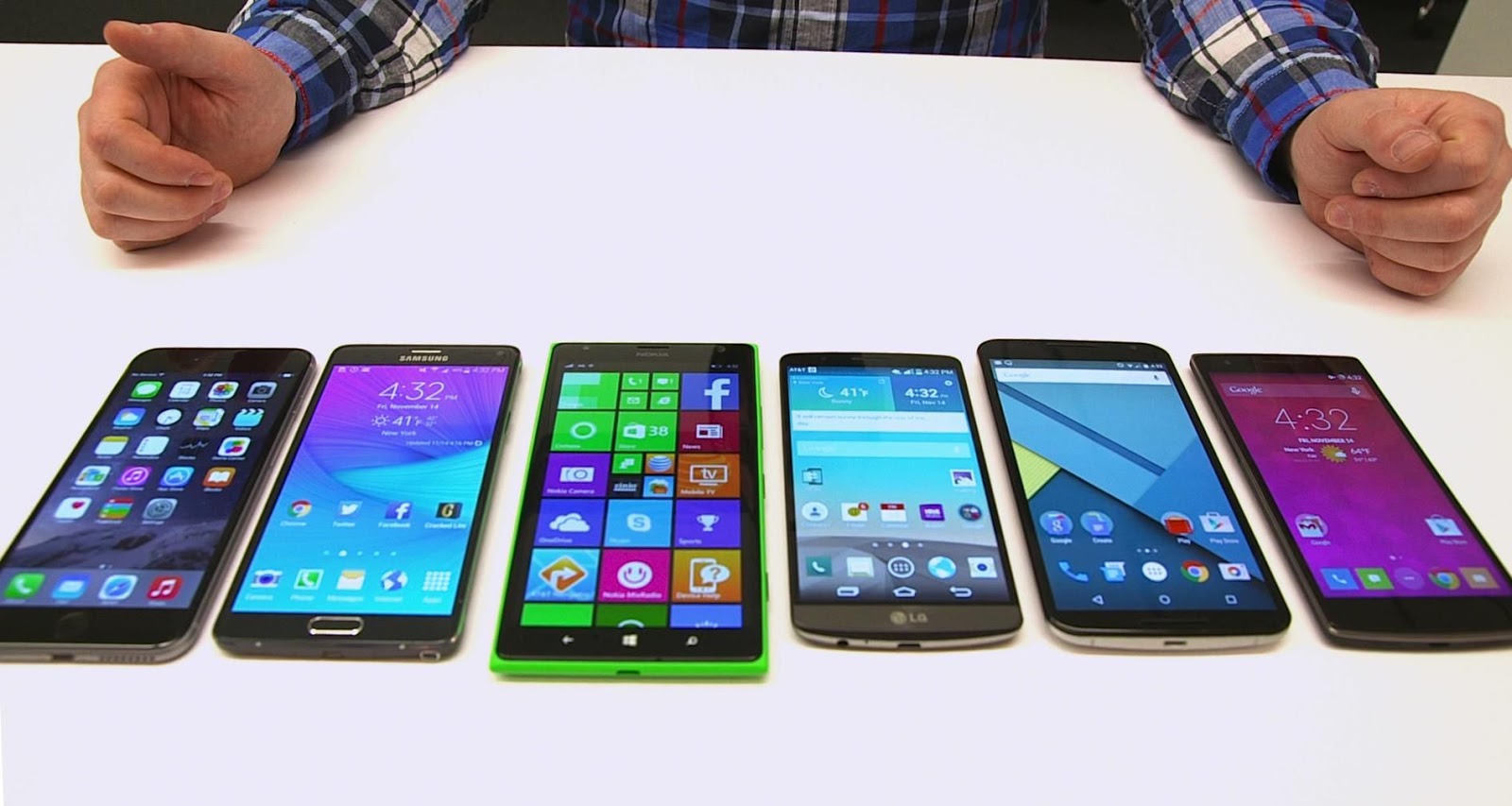
Hi, Giktayms! Before the appearance of devices with color screens on the market, mobile phones, as a rule, were evaluated according to two criteria: design and functionality (well, so that polyphony with ringtones was, of course). But when smartphones became widespread, users began to notice that someone had a brighter display, somewhere more juicy, and on some screens you don’t want to look at all. With all these designations like IPS, Retina, AMOLED and TFT, you can get confused, so let's try to figure out where the grass is greener (literally). If you also want to know, we invite under the cat.
The tendency to an increase in the diagonal of the screens of smartphones seems to have disappeared - manufacturers realized that 8-inch phones are not bought so well, and buyers clearly identified the optimal diagonal for themselves: from 4.7 inches to 5 inches. Even Apple, which for a long time was carrying out its approach to accessing the entire screen with the “thumb of one hand” from 3.5 inches, eventually succumbed to the desires of users and began to stamp large smartphones. Many of them still call them “shovels” out of habit, but now this is no longer the case.
The quality of the picture on the diagonal of the display is practically independent - here the question is in the convenience of use. Some have longer fingers, others need the phone to easily fit in a small trouser pocket, and so on. Resolution is responsible for image quality: the higher it is, the clearer the picture. Accordingly, on high-resolution screens, it is either impossible to discern individual pixels with the human eye, or a number of efforts should be made to do this.
')
| Resolution | Where meets |
| 480 x 800 (WVGA) | Used rarely in budget smartphones, with a maximum of 4 inches, rarely 5 inches |
| 540 x 960 (qHD) | Resolution for "state employees" with a diagonal of 4-4.5 inches |
| 720 x 1280 (HD) | Medium-priced smartphones, diagonal from 4.7 inches to 5.5 inches ( Xiaomi Redmi 4 ) |
| 1080 x 1920 (Full HD) | Flagship resolution, used in smartphones with a diagonal of 5 inches and above (for example, Xiaomi Mi Max ) |
| 2560 x 1440 (QHD) | Premium segment smartphones (LeTV Leeco Le Max 2 and others) |
| 3840 x 2160 (4K) | Experimental resolution for Samsung and Sony devices |
Here again, it should be noted Apple, who decided to stand out and use non-standard resolutions - 640 x 1136 and 750 x 1334 (used in the iPhone 7 Plus), focusing on pixel density (Retina). If we are dealing with a mid-range smartphone, HD is preferred here - for example, Redmi 3S ($ 122.99 for the XRBTGB promo code) and Redmi 3 Pro ($ 142.99 for the JCWKH coupon). The rest of the manufacturers from the template try not to depart, using mainly Full HD (Xiaomi Mi5 ( $ 399.99 with ROTHQ coupon ) and others) - this is indicated by statistics.

Pixels around the head
We have not for nothing touched on the theme of pixels in the last paragraph - a lot depends on the pixel density indicator (dots per inch, ppi). With the same screen resolution, but a different diagonal, the pixel density will be different. Apple, for example, says that the human eye cannot see pixels from a distance of 30 cm and 300 ppi, so it does not use screens with a high density of dots. Why, if it will be perceived as well, and the cost will increase?
But many other manufacturers continue to claim that the human eye is actually not so “blind” and is quite capable of distinguishing between 300 and 400 pixels. Therefore, they offer smartphones with an indicator of 400 ppi and higher, the cost of which does not necessarily exceed $ 500 - take for example the same Lenovo X3 Lite with 401 ppi or LeTV LeEco Le 2 Pro with 403 ppi ( $ 178.99 for the VYLDFS promo code ). Does this make sense? In general, the image really looks better, but at 300 ppi you will also be quite happy with the picture. The main thing is not to forget about the optimal ratio between the screen diagonal, its resolution and pixel density. For example, if to get a good picture, the HD resolution still goes for 4.7 inches, then here, 5.5 inch smartphones will already need Full HD.

In fact, many people use smartphones with a pixel density of 250-300 and do not pay attention to the points. However, it is simply impossible not to notice them at a ppi below 200, and this gives a certain discomfort.
But the diagonal, screen resolution, pixel density - all of this is secondary compared to another important criterion. Therefore, we turn to the main thing - the technology of manufacturing screens.
What do the matrices conceal?
In modern smartphones, the most common are three technologies for the production of matrices - AMOLED, which uses organic light-emitting diodes, and two more, based on liquid crystals (LCD) - IPS and TN + film. TFT technology is used in all types of screens: thin-film transistors are used to operate each subpixel. As a rule, TFT matrices use amorphous silicon, but recently manufacturers have begun to introduce new LTPS-TFT technology using polycrystalline silicon. The size of the transistors is smaller - the pixel density is greater, even 500 ppi is not the limit. Such smartphones are already there, OnePlus One with 401 ppi was one of the pioneers.

All LCDs work on the same principle. The current is applied to the molecules of liquid crystals, sets the angle of polarization of light, after which the latter passes through a light filter and is painted in the color of the desired subpixel. In budget smartphones, TN matrices with a low viewing angle (no more than 60 degrees), low contrast and color rendition are still used.
LCD displays are divided into active and passive. Passive matrices are STN, the technology of twisted crystals, and its advanced cousins are CSTN, FSTN and DSTN. The latter is distinguished by the fact that in such a matrix a two-layer cell consists of two STN cells. When working molecules rotate in opposite directions, and the transmitted light loses most of its energy. Active matrices include TFTs, which we talked about earlier.
Therefore, the TN has replaced the technology IPS (SFT). Although the IPS-matrices and 20-year history, now they remain very technological. The viewing angle they have reaches 180 degrees, a high level of color and pixel density. IPS can also be both cheap and expensive, and the difference between them is immediately visible: the cheaper, the smaller the viewing angle, and the colors are faded. From the quality it is worth noting AH-IPS from LG and PLS matrix from Samsung. The latter show about 98% of IPS colors, have low power consumption and are 20% cheaper.
In IPS matrices, control electrodes are distributed on one surface so that the electric field lines can take on a horizontal shape. As soon as voltage is applied, the liquid crystals unfold in the same plane. Since the IPS cell is locked, it transmits less light, and color rendition occurs without dips.
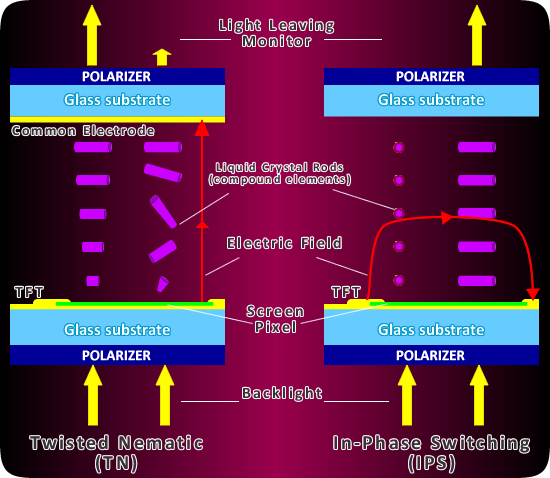
IPS-matrix for several years, popular among manufacturers of smartphones. They can be found both in the same Xiaomi Mi4 , and in DOOGEE X5 MAX or even flagships like the Huawei Mate 8 . One of the smartphones that combines IPS-matrix and high ppi is Lenovo K5 Note: is in gold ($ 153.99 for the promotional code LK5GB ) and silver ($ 150.99 for the promotional code for LKGB ).
OLED arrays, based on organic light-emitting diodes, are very different from IPS. In this case, the light source are the subpixels themselves, respectively, there is no need for external illumination, due to this, such screens are thinner than liquid crystal ones. One of the varieties of OLED - AMOLED, and is used in modern flagships. Subpixels (each separately) are controlled using an active TFT matrix. AMOLED displays are very good for displaying a deep black color, since it is enough for it to just turn off the LEDs. The black parts of the screen simply do not consume energy, so such matrices are also quite economical.
AMOLED has a high level of saturation of colors - sometimes even so saturated that they seem unreal, and you have to adjust this parameter using settings. Current smartphones are no longer suffering from such a disease, but some manufacturers still provide users with the opportunity to bring the picture closer to IPS-screens.
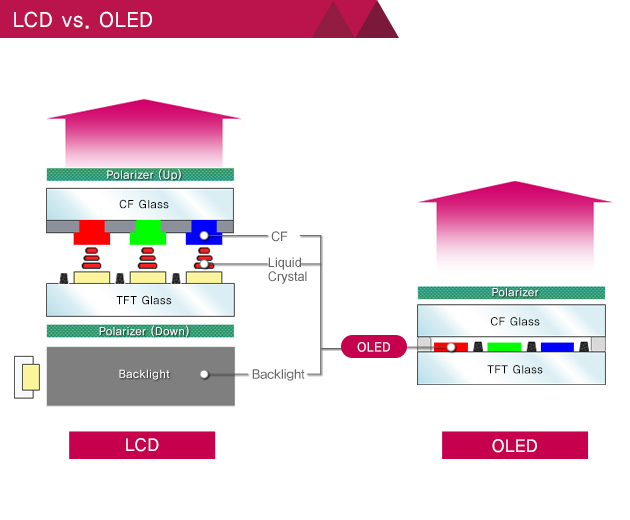
Obviously, AMOLED has several advantages compared with IPS: high brightness and contrast, compactness, smaller display thickness, color reproduction. Therefore, OLED displays are more expensive and more difficult to manufacture than LCDs. At first, AMOLED screens differed in the unequal life of the LEDs of different colors: after some time, the subpixels burned out, from where the residual image originated. Modern organic LEDs are designed for at least three years of continuous operation, so you can safely buy AMOLED smartphones: for example, OnePlus 3T or Huawei P9 Plus .
Now everything goes to the fact that in the future all smartphones will be equipped with OLED-displays. Even Apple, according to rumors, plans to abandon IPS and use OLED (maybe even flexible) on the iPhone 8. The only manufacturers of the corresponding equipment can be counted on the fingers - at the moment it is barely enough for the needs of vendors. What will happen if Apple joins them with its hundreds of millions of iPhones a year? It's scary to think.
Subpixel matters
Yes, not only the type of matrix affects the picture, but also the location (picture) of subpixels. If we talk about LCD, then in these matrices the RGB pixel consists of three elongated subpixels.
They are usually made either in the shape of a rectangle or an obtuse angle.
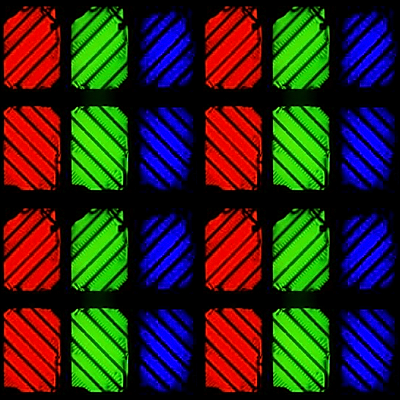
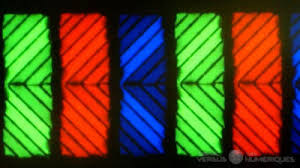
The AMOLED matrices are much more complex. The human eye is very sensitive to green light, and since the subpixels themselves glow here, using the same pattern as in the pictures above would result in loss of color reproduction. The PenTile technology came to the rescue: it used red-green and blue-green pixels: the red ones looked more like squares, the blue ones looked like rectangles, and the green ones were too elongated. The first version of PenTile was quickly abandoned, since the pixels were clearly visible, and white light was given in gray.
The solution was found in the form of the Diamond PenTile technology (did they notice that marketers like to add diamonds to everything?) - a new type of drawing, in which the red, blue and green subpixels are made in the form of squares. The "gray" of white color disappeared, and the remaining problems were solved by a banal increase in the number of pixels per inch. Samsung still uses the Diamond PenTile in its Galaxy S7 and S7 Edge smartphones.
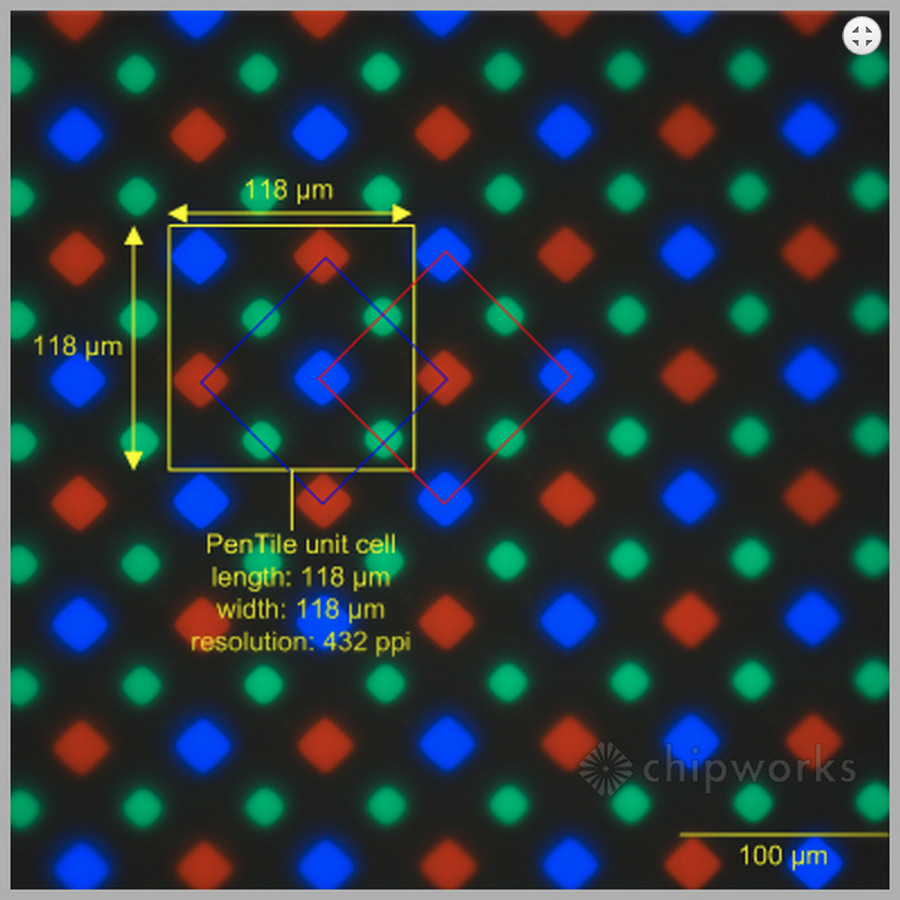
So if you decide to take a smartphone with AMOLED, be sure to pay attention to the ppi indicator. Ideally, it should be at least 300.
A number of design features of the screen are also important. For example, the absence of an air gap between the projection-capacitive sensor and the display has increased the maximum brightness, color and viewing angle - the sensor and matrix in this case are combined into a single whole (OGS). Yes, replacing the glass separately from the display is much more complicated, but OGS has much more advantages.
Gorilla Glass: Is It Necessary?
For a long time, another trend has become common among the manufacturers of smartphones - to install Gorilla Glass. In short, for the production of such glasses is used silicon dioxide with some chemical additives and high temperatures - more than 1000 degrees. Hardening occurs due to the occurrence of internal stresses of a certain type: compression at the surface and tension in the core.
In 2014, the company Corning introduced Gorilla Glass 4, while the emphasis was placed on the strength of glass, which was to survive the fall on solid surfaces - tiles, asphalt, and so on, though from a height of no more than one meter. In July of this year, a new generation of Gorilla Glass 5 was announced: according to manufacturers, it is 1.8 times stronger and can withstand a fall from a height of 1.6 meters in 80% of cases. Does this in any way affect the image quality and responsiveness of the display? In fact, no, and if it does, the human eye is hardly able to notice it. Therefore, when you choose smartphones with Gorilla Glass, you invest not so much in the picture, color rendition, etc., but in that the glass does not break when it falls (and if the phone is also waterproof, it can get into the “Rusian” ). Now there are a lot of smartphones with Gorilla Glass, the same Lenovo ZUK Z2 , LEAGOO M8 or ASUS ZenFone ZOOM . Soon, manufacturers and the fifth generation will begin to actively exploit.

What future awaits us
IPS, OLED, AMOLED - this, of course, is far from the limit of modern technologies. QLED screens are being actively developed, where quantum dots are used - microscopic pieces of semiconductors. According to experts, the QLED matrix will provide a high level of brightness and color reproduction, while still being energy efficient. The future also belongs to flexible displays - although they are not yet in mass production, the technology itself is developing at a rapid pace: a couple of months ago, Russian chemists, in collaboration with the University of Groningen from the Netherlands, were able to produce organic material suitable for producing flexible displays in a cheaper and simpler way. So look carefully, and look at both!

Somewhere wrong? Correct us in the comments.
Source: https://habr.com/ru/post/373011/
All Articles